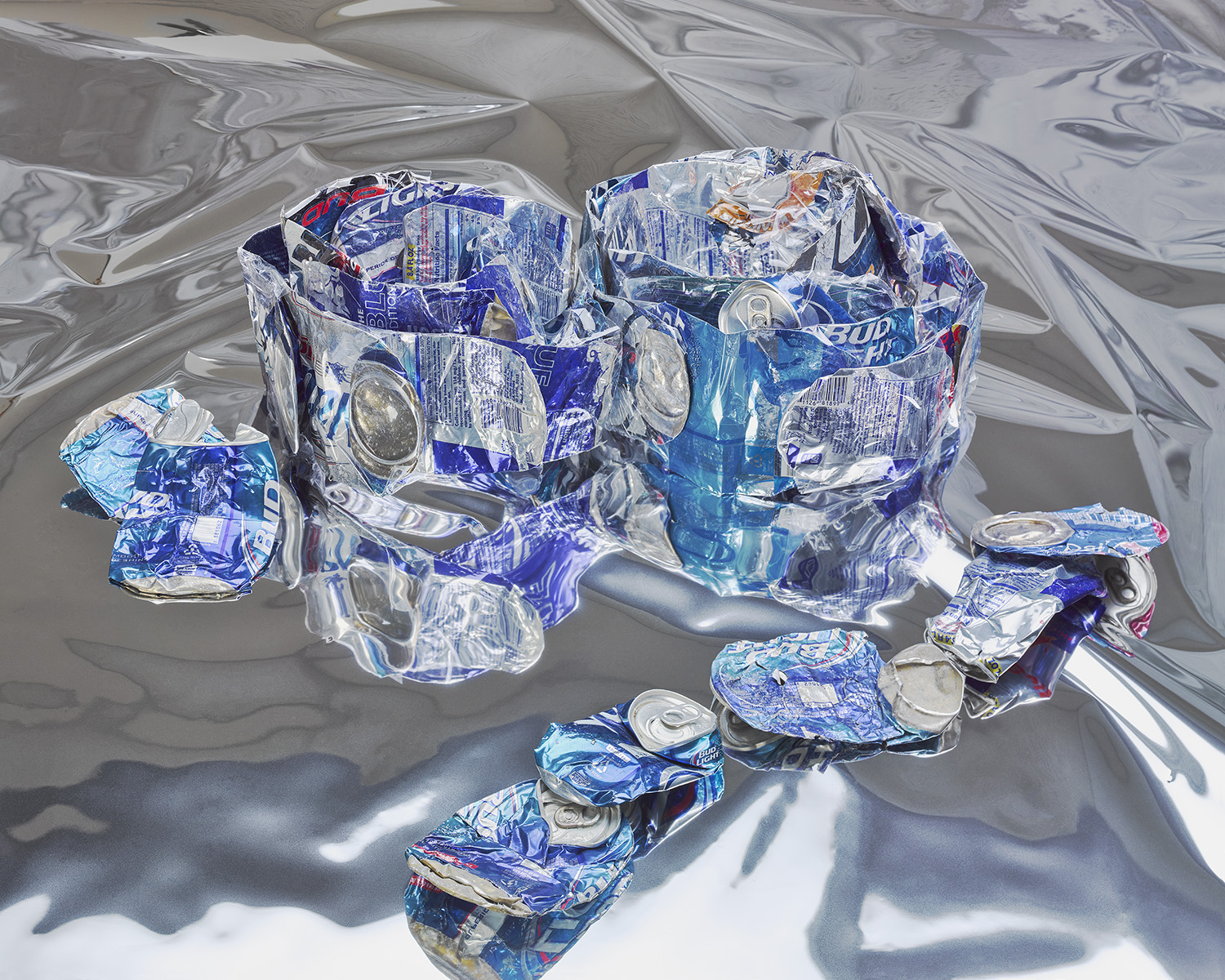My transformation of aluminum detritus into fantastic underwater sea creatures refers to the contrast between our disregard for the environment and our simultaneous dependence upon it for our survival. Aluminum packaging becomes symbolic of our use of natural resources as the images suggest fanciful options for the recycling of post-consumer waste. These photographs document objects that are assembled to create sculptural forms. Collected during walks in my neighborhood, this litter can be described as the “trash of trash.” I affirm the materiality of objects that we tend to “delete” from our visual field, despite their prevalence in our urban environments. I hope to encourage an embrace of the potential actions of reduce, reuse, recycle, and conserve, while fostering reconsideration of our daily habits, and their eventual global impact.
In my staged photographs, I constructed these undersea worlds to reference our impact on the environment, using aluminum packaging to describe aquatic creatures. The fluid, silvery background echoes the resting place for litter, namely our local streams and lakes. The sculptural forms suggest the possibilities of these aluminum cast-offs. Meanwhile, my landscape photographs record similar objects that have traveled through gutters and sewer drains to become lodged along local creek beds. Specific locations are marked with GPS coordinates, to draw the connection between commonplace discarded items and their ultimate final resting place in our environment.Through my artwork, I explore the powers of attraction and repulsion and reflect on questions relating to sustainability. Using digital technology, I embrace process and materiality to underscore the physical nature of things that exist in a transitory state, in order to elevate, to impart value.
artist statement - utopian dilemma
I explore connections between photography and sculpture by investigating the object and its materiality, while commenting on the potential for recycling. Photography’s role in fixing the object, in the generation of a record, becomes enlisted in this project, as I consider notions of permanence and the transitory, of value and waste. These photographs document objects collected during walks around my neighborhood. I chose aluminum metal because it endures as a visible emblem of the traces of consumer products that mark our environment. Aluminum forms are reclaimed and molded into a new sculptural structure, presented in these photographs as an idealized, yet absurd comment on the possibilities for reuse. My sculptures are bound by rubber bands and tape, which add tension and foreground their temporary or transitional status. The material characteristics of the aluminum itself, which both resists and allows folding and bending, guide the creation of these forms. The emphasis on detail invites visual scrutiny, as I elevate these objects, underscoring the potential of the material, which can be recast, transformed into something new. By using a high resolution medium format digital back on a view camera with full movements, and illumination provided by studio lighting, my practice parallels that found in commercial photography, with an emphasis on description, on rendering the object as something unique, to be desired.
The designation of an object as something of value or as waste can swing quickly from one category or the other, forming part of the larger cycle of consumption. As scholar Brian Thrill notes, “The indifference engine that drives litter is the flip side of desire. It’s the waste we could not bring ourselves to care even a little bit about, when we had, just moments before, cared about some part of the thing we’re throwing out very much” (Thrill, 21). This movement from intimate use, by holding the item in one’s hand, to quasi-invisibility, as it lies in a gutter, becomes manifested in the accumulation of litter. Aluminum, as a category of litter, is unusual, due to the potential for recycling and its monetary value as a material. Ultimately, I am drawn to the concept of how we assign value to objects and how that process fluctuates over time. A consumer economy is dependent upon the constant need for the purchase of goods. In order to acquire new products, the used, obsolete, outdated objects must be discarded; we seek to remove them from our everyday lives, our personal space, our visual field.
The landscape images record similar aluminum “shells” that have traveled through gutters and sewer drains to become lodged along a local creek bed. Specific locations are marked with GPS coordinates, to draw the connection between commonplace discarded items and their ultimate final resting place in our environment. There is a correspondence between the objects that I photograph, designed to prioritize convenient access to beverages, and the fact that they end up often in waterways, which in one form or another remain the source for their contents. I began to refer to the overlooked areas of creeks and lakes that form a bridge between the objects that I collect and the environments where the ultimately are found.
As we confront our contemporary existence, our desire for convenience and embrace of consumerism, we find ourselves faced with a Utopian Dilemma. The euphoria of modernism, with its promise of an elevated standard of living achieved through the availability of affordable mass-produced goods, has been replaced by an anxiety aligned with 21st century concerns regarding sustainability. We consider Utopia to be an idyllic place: freedom from want in a land of plenty. I strive to transform the discarded by inverting our value system, inspired by Thomas More’s 16th century story of Utopia. Responding to Thomas More’s Text, media scholar Stephen Duncombe observes that Utopia (translated as “No Place”) "is the world turned upside down," where gold becomes worthless (40). I turn trash into treasure with the hope to prompt changes in social behavior.
Duncombe, Stephen. “Imagining No-Place: The Subversive Mechanics of Utopia.” Utopia & Contemporary Art. Eds. Christian Gether, Stine Hoholt, and Marie Laurberg. Ostfildern, Germany: Hatje Cantz Verlag, 2012. 39-46. Print.
Thill, Brian. Waste. New York: Bloomsbury, 2015. Print.

